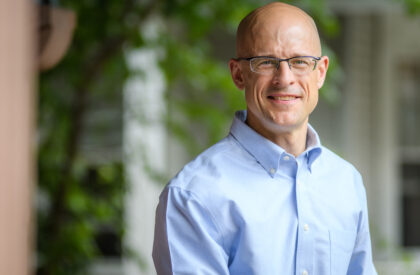Marsh Institute to lead water research fueled by $2.4M in grants
Clark University researchers are starting work on two parallel, federally funded grant projects, one examining water quality in a watershed facing pollution challenges and the other studying water quantity in an area rich with farmers amidst a severe drought.

Robert Johnston, an economics professor and director of the George Perkins Marsh Institute, is the principal investigator on “Next Generation Choice Experiment Architecture for Spatially-Explicit Agricultural Conservation and Ecosystem Service Valuation,” a $799,994 project funded by the U.S. Department of Agriculture (USDA). The project will develop novel survey-based techniques to evaluate Virginia residents’ economic value for agricultural conservation programs that improve water quality in different ways. The project focuses on relationships between the spatial dimensions of water quality change due to different possible types of agricultural conservation and the benefits received by households.
Dana Bauer, assistant director and research scientist at the Marsh Institute, and Johnston are co-principal investigators on “Conservation Incentives and the Socio-Spatial Dynamics of Water Sustainability,” a $1,596,980 grant from the National Science Foundation. The five-year project, which involves researchers from six universities, will study incentive-based water conservation in areas with significant agricultural use. Work will concentrate on the Red River, the second-largest basin in the south-central United States, along the border of Oklahoma and Texas, where hundreds of farmers live and work.
“In Virginia, we’re studying the effects of agricultural activity and conservation on downstream water quality. In this project, the primary concern isn’t how much water farmers are using but potential effects of agricultural activities on water quality downstream,” Johnston says. “In Oklahoma, we’re dealing with the western U.S., much of which is in one of the most severe droughts we’ve seen in centuries. There, water conservation is crucial.”
The project team hopes to survey 4,000 people across Virginia, with a focus on the Chesapeake Bay watershed, which has faced pollution problems for decades. The project will develop biophysical models to predict the spatial distributions of water quality changes under different possible agricultural conservation programs. For example, some USDA programs provide incentives for farmers to conserve wetlands or forested riparian buffers. Outputs of these models will be used to develop a “choice experiment” questionnaire that will ask households whether they would support programs such as these in a binding statewide referendum, at different possible costs to their household (for example, in taxes and fees necessary to fund conservation activities). Detailed maps will complement the survey, displaying where potential improvements would be located and where the water quality could change. Results of the survey will be used to estimate what different households would be willing to pay for different types of changes in different areas.
It’s expected that many residents will value water quality improvements close to their homes. However, others may put a high value on changes in other areas, such as those they use for recreation, or other areas that might not be anticipated by the researchers. “Some people who are upstream of agricultural conservation might not see any water quality improvements in their local area because effects on water flow downstream,” Johnston says. “People might still value those changes — but perhaps not as much as they would if the same changes were closer to their homes. Spatial dimensions such as these are crucial to understanding the economic value of water quality changes to society.
“We’re trying to create a technique that will allow us to estimate how much the general population would value changes from different types of agricultural conservation activities, due to impacts on water quality,” he says.

In Oklahoma, researchers will survey farmers about water conservation. A team of economists, including Bauer and Johnston, ecologists, engineers, and a psychologist will examine what factors may prompt someone to either support or resist conservation measures. For example, farmers located downstream may not be willing to conserve water if they believe their peers located upstream are not also participating.
The multi-disciplinary project will create an integrated simulation model with various scenarios of conservation budgets, incentives, and ecosystem feedbacks. Some scenarios will consider climate variability. The goal is to provide insights on how interactions among social and ecological spatial components affect the sustainability of human-freshwater systems under incentive-based conservation.
“We’re looking at rivers that are already stressed in terms of water availability. Climate change is drying up many of these rivers, so it’s becoming even harder for people to agree to conserve,” Bauer says.
Bauer and Johnston will complete their work during the first three years of the five-year project. Also participating will be Lillian Sartorius ’22 and postdoctoral researcher Tom Ndebele. They’ll begin with surveys and focus groups, asking farmers about their willingness to participate in voluntary conservation programs and identifying potential barriers to doing so.
Bauer anticipates the team will discover differences in how farmers value their stewardship of water resources. She hopes the surveys will allow researchers to group which farmers are good candidates to participate in conservation programs, which farmers may need more education and encouragement to participate, and which farmers are unwilling to participate and why they’ve made that decision.
Helping conservation organizations target the right farmers, Bauer says, will maximize the potential cost-effectiveness of water conservation programs and associated benefits to the ecosystem.


